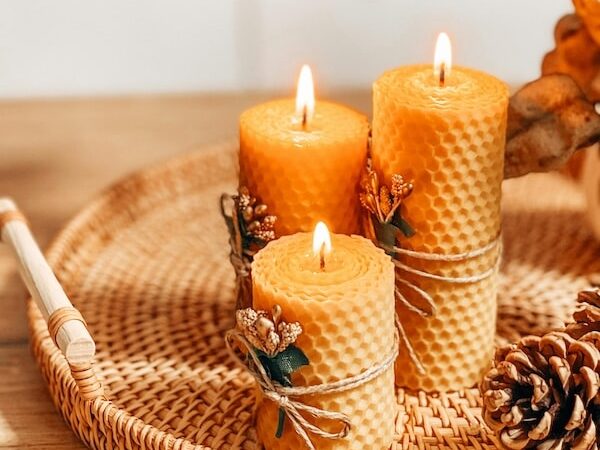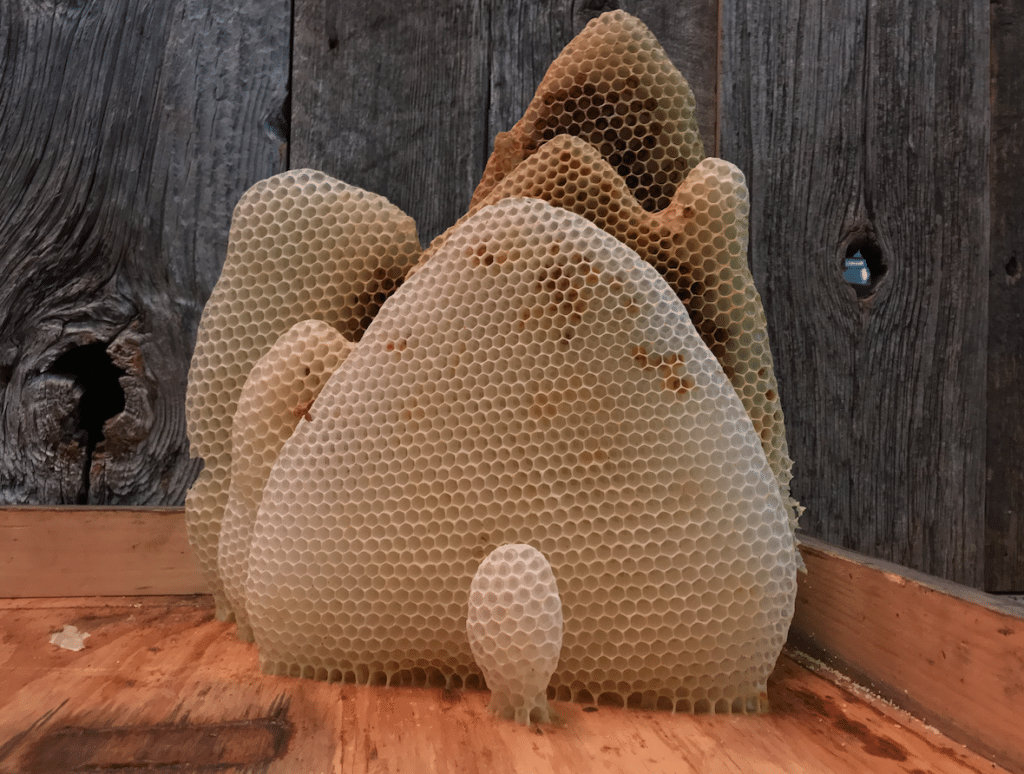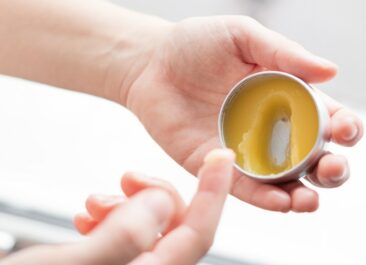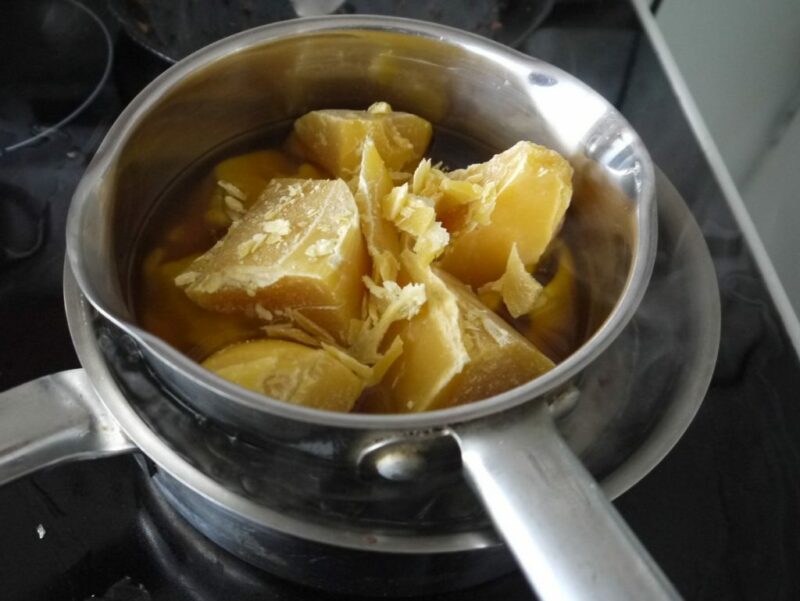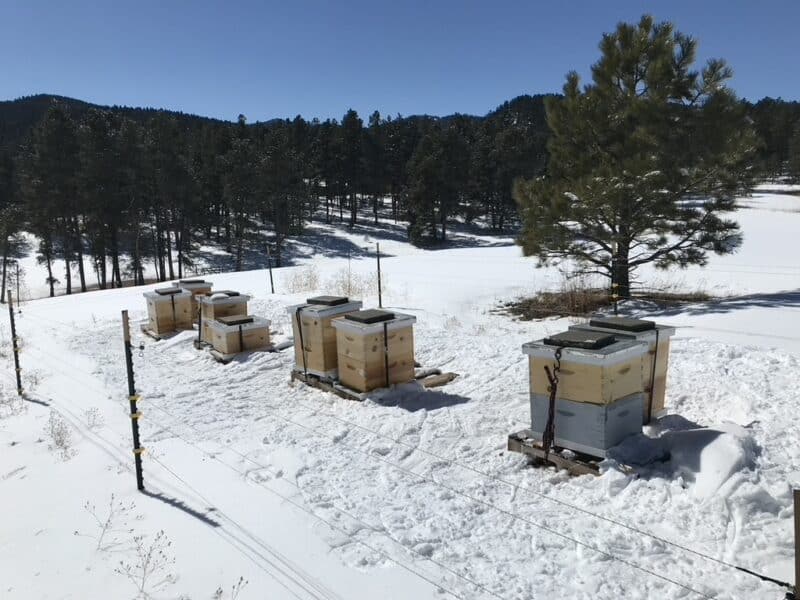Contents:
- What is Beeswax?
- How is Beeswax Produced?
- Characteristics of Beeswax
- Properties of Beeswax
- Benefits of Beeswax
- Historical Uses
- Common Uses of Beeswax Today
- How to Melt Beeswax
- FAQs
What is Beeswax?
Beeswax is a waxy substance created by young honey worker bees. In beehives, beeswax is used by worker bees to create cells. The hexagonal design of these cells creates the iconic “honeycomb” pattern.
Chemically, beeswax is composed of over 280 different compounds, primarily monoesters (45-55%), hydrocarbons (15-18%), free fatty acids (10-15%), diesters & complex esters (8-12%), hydroxy monoesters (4-6%), and free fatty alcohols (1-2%). Exact composition can vary by bee type, location and conditions.
–– We pioneered the process of identifying the exact percentage of various pollen species found in honey through advanced genomic sequencing. Learn more on our Research page ––
Beeswax is not water soluble. It has a relatively low melting point—around 60-65 degrees centigrade, making it easy to work with. The chemical composition of beeswax makes it both a structuring and plasticizing agent — meaning it can thicken solutions and thin others, depending on what it is combined with; this dual functionality makes it a highly effective agent in cosmetics, where both qualities are in demand.
How is Beeswax Produced?
Young worker bees are fed copious amounts of honey inside the hive, and their bodies digest the honey, using the nutrients to form wax which is secreting in thin scales from wax glands in their abdomens. The wax scales are gathered by other worker bees, who chew it to soften it, making it pliable enough to be formed into cell walls. Through this process, bee colonies create the comb in which they raise new bees, transform pollen into “bee bread,” and store honey.
Characteristics of Beeswax
When beeswax is first created, it’s a soft, white, malleable substance. Once formed into cells, it becomes harder, in order to form stable cell walls. Over time, the presence of propolis, pollen and honey in cells changes the color of beeswax. The longer wax is inside a hive, the darker it becomes, from white to a pale gold to amber to brown. Wax from brood cells is the darkest because of the pupal cocoons left in the cells. Different kinds of nectar produce different colors of honey, and these affect the color of beeswax as well.
In processing beeswax, beekeepers filter melted wax, removing impurities, and lightening the color. Commercial beeswax manufactures may even bleach it to return it to its original white color.
Beeswax fresh from the hive can smell like a subtle mix of honey, floral spices & resins, and the wood of the bee box and frames. Both the scent and color of beeswax can vary between seasons and hives due to the pollen, resins, nectar, and honey that the wax comes in contact with. Just like how the taste of honey can change depending on the pollen collected by the bees, the same effect happens to the beeswax.
Properties of Beeswax
Beeswax is a natural, organic substance that is malleable, chemically soluble, water insoluble, edible and flammable. As a malleable substance it can be molded into different shapes to make a variety of useful and decorative things. Because of its malleability, it’s sometimes called “the world’s first plastic.”
As a soluble substance, it can be melted and mixed with other substances to create many different health & beauty and home care products.
As a water insoluble substance, it can be used to seal joints and water proof surfaces.
As an edible substance, it can be eaten, and while not digestible, it can provide roughage and some beneficial chemicals to the human system.
As a flammable substance, beeswax can be used to make candles that burn cleaner and brighter than paraffin candles.
Benefits of Beeswax
Beeswax has a multitude of natural benefits, and although it is edible, beeswax is most commonly added to everyday personal care routines. A few advantages to using beeswax include:
Moisturizing Components: Beeswax locks in moisture and can help keep the skin firm and plump. The anti-allergenic and anti-inflammatory properties soothe easily irritated skin, making it one of the best skincare ingredients for healing rosacea or eczema.
Ability to Protect from Irritants: Beeswax can also act as a layer of protection when applied to the skin. It can protect the skin from environmental irritants and extreme weather.
Promotion of Hair Growth: Beeswax not only moisturizes and soothes hair, but it can keep natural moisture from getting out of the hair. It also stimulates hair growth and reduces hair loss.
Historical Uses
The first identified use of beeswax was to fill a cavity in 6500+ year-old tooth discovered by archeologist in Europe. Other ancient uses of beeswax were as an ingredient in nail polish and in medicine in early China (c. 2500 BCE), and as a haircare product, painting medium, and ingredient in embalming mummies in Egypt. Beeswax has been found on clay pots from the 5th millennium BCE—no doubt used as sealant to make the pots waterproof. Greeks and Romans mixed beeswax with olive oil and herbs to create salves to treat sores, cuts and burns, and as cosmetic creams to moisturize skin.
From the dawn of writing, beeswax has been used to seal documents and letters. With the invention of metal casting, beeswax has been used in a process known as the “lost wax method” to create bronze statues and gold and silver jewelry.
Beeswax candles have been found in early Egyptian tombs and were used by the wealthy throughout the Mediterranean during the classical period (poor people used cheaper oil lamps). Beeswax candles became popular in Christian churches in the Middle Ages, as they burned bright and gave off little smoke.
Common Uses of Beeswax Today
Beeswax is an incredibly versatile substance — it can be mixed into solutions to create a host of medical, cosmetic and home care products, made into candles, eaten, melted and molded into ornaments and used as a sealant.
These are just 50 of the many ways you can use beeswax and products made with beeswax to improve your life:
- Lubricate door hinges
- Make all-natural lipstick
- Season cast iron pans
- Coat garden tools to prevent rust
- Polish shoes with a solution of beeswax, olive oil and pigment
- Decorate your Christmas tree with molded wax ornaments
- Light your dinner table with smokeless beeswax candles
- Polish furniture with a solution of olive oil, beeswax, and lemon oil
- Condition cutting boards and wooden spoons
- Refill tealights with beeswax
- Mix with pigments to make encaustic paint
- Lubricate screws to make them easier to screw in
- Heal cuts with a salve made of olive & coconut oils, beeswax, vitamin E and calendula, lavender, and chamomile
- Make fire starters out of pinecones and beeswax
- Keep bronze and brass items shiny
- Tame flyaway hair
- Fill cracks in wood
- Rejuvenate old leather
- Coat cloth to make reusable wrap for cheese and vegetables
- Coat nails to prevent wood splintering
- Make lip balm out of shea butter, beeswax and coconut oil
- Soothe bug bites with a solution of tea tree oil, lavender, beeswax, and calendula oil
- Soften cracked skin on feet
- Seal jars of preserves, jams and pickles
- Polish granite countertops
- Keep snow from sticking to snow shovels
- Mix with sugar and fruit flavorings to make gummy candies
- Style your hair with a natural alternative to gels and pomades
- Polish and preserve copper pots & pans
- Make kid-safe, non-toxic modeling clay
- Apply as an acne treatment
- Create solid perfumes using beeswax, almond oil, essential oils, and dried flowers
- Make craft soaps out of olive, coconut, castor & palm oils, beeswax, honey, lye, and essential oils
- Treat eczema and psoriasis with a solution of beeswax, honey and olive oil
- Eat it to help lower your cholesterol
- Put is on your pets’ feet to protect them from wear
- Lubricate musical instrument strings and reeds
- Make wooden drawers slide smoothly
- Condition unfinished furniture
- Waterproof shoes and boots
- Make body butter out of coconut oil, shea butter, and beeswax
- Preserve cheese with a thin coating of beeswax
- Soften and style beards and mustaches
- Apply a coating to snowboards, skis and surfboards to improve their glide
- Wax flyfishing line to help it float
- Coat baking pans and cookie sheets to make them non-stick
- Make crayons out of cocoa butter, carnauba wax, beeswax, and pigments
- Treat diaper rash with a solution of honey, olive oil, and beeswax
- Wax thread to prevent tangles while sewing
- Chew it instead of gum
How to Melt Beeswax
Many home uses for beeswax require melting it. Because beeswax adheres to surfaces and is difficult to remove — one reason why it’s such an effective waterproofing agent — the best way to melt beeswax is in a disposable metal can. To melt beeswax at home, you’ll need only a deep pan, a clean can, a block of beeswax, water, metal spoon and a heat source.
Step 1:
Thoroughly clean and rinse a large metal can, such as a 32 oz. can you might have left over from stock or tomato sauce.
Step 2:
Place the can in a deep pot and fill the pot with hot water halfway. Shave slices of beeswax into the can.
Step 3:
Set heat to medium and bring water to a low boil, stirring the beeswax with a metal spoon until it melted.
Step 4:
If coloring wax, add pigment and stir to blend thoroughly.
Step 5:
Turn off heat and pour melted wax into solution or mold.
FAQs
Q: What is beeswax?
A: Beeswax is secreted from glands in honeybees’ abdomens. While beeswax includes over 280 substances, it consists primarily of five compounds: monoesters, hydrocarbons, free fatty acids and diesters & complex esters.
Q: Is beeswax safe for human use/consumption?
A: Beeswax is a natural substance that is rarely if ever harmful to humans; it can be safely consumed or applied to the skin as a lotion or balm. Beeswax is flammable, with a relatively low flashpoint (around 400 degrees Fahrenheit), and so should be used with caution in cooking and around open flames.
Q: Why do bees make beeswax?
A: Honey bees make beeswax to create combs — thin-walled hexagonal cells used as places to raise new bees, transform pollen into “bee bread” and store honey.
Q: Why is beeswax used in so many ways?
A: Beeswax is malleable, chemically soluble, water insoluble, edible and flammable, which means it can be molded into objects on its own, melted and mixed into solutions, used to waterproof surfaces, eaten, or used to start fires or provide light. The unique chemical composition of beeswax makes it both a thickening and thinning agent, depending on what it is mixed with — this means it can be used to create solid objects, such as crayons, candles and ornaments, or viscous solutions such as balms, ointments and lubricants.
Q: Can you make things at home with beeswax?
A: While there are a host of commercial products available that are made in part out of beeswax, there are many products made of beeswax you can make at home, from soaps, lips balms and skin moisturizers, to shoe & boot waterproofing and polish, to counter & furniture polish, hinge lubrication and pot & pan polish & preservative.


